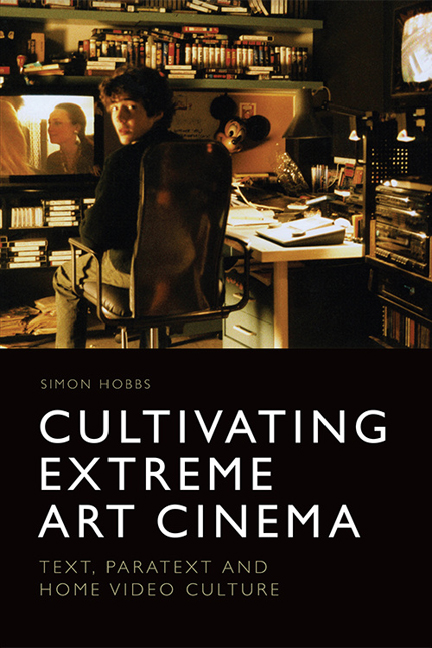Book contents
- Frontmatter
- Contents
- List of Figures
- Acknowledgements
- 1 Introduction
- 2 Art and Exploitation: Crossover, Slippage and Fluidity
- 3 Early Extremity on DVD: History, Precursors and Exploitation Auteurs
- 4 Weekend and Cannibal Holocaust: Art, Ballyhoo and Remediation
- 5 Salò, Or the 120 Days of Sodom and Ilsa, the Wicked Warden: Fascism, Pornography and Disgust
- 6 Contemporary Extremity on DVD: Trends, Hard-core and Geographic Mobility
- 7 Michael Haneke: Glaciation, Legitimacy and Transgression
- 8 Lars von Trier: Provocation, Condemnation and Confrontation
- 9 Conclusion
- Bibliography
- Index
1 - Introduction
Published online by Cambridge University Press: 28 April 2021
- Frontmatter
- Contents
- List of Figures
- Acknowledgements
- 1 Introduction
- 2 Art and Exploitation: Crossover, Slippage and Fluidity
- 3 Early Extremity on DVD: History, Precursors and Exploitation Auteurs
- 4 Weekend and Cannibal Holocaust: Art, Ballyhoo and Remediation
- 5 Salò, Or the 120 Days of Sodom and Ilsa, the Wicked Warden: Fascism, Pornography and Disgust
- 6 Contemporary Extremity on DVD: Trends, Hard-core and Geographic Mobility
- 7 Michael Haneke: Glaciation, Legitimacy and Transgression
- 8 Lars von Trier: Provocation, Condemnation and Confrontation
- 9 Conclusion
- Bibliography
- Index
Summary
Acts of unsimulated sex and extreme violence have become increasingly visible within a number of contemporary art films. Films such as Funny Games (Haneke 1997), Romance (Breillat 1999), Trouble Every Day (Denis 2001), Irreversible (Noé 2002), Twentynine Palms (Dumont 2003), A Hole in My Heart (Moodysson 2004), 9 Songs (Winterbottom 2004), and Antichrist (von Trier 2009) push the limits of acceptability by hybridising art cinema traditions with exploitation film techniques. By merging slow, often banal narratives and experimental visuals with sequences of extreme, gory violence; real, penetrative sex; and controversial and taboo themes, these difficult and at times offensive films straddle the divisions between ‘high’ and ‘low’ culture, breaching longstanding taste distinctions. In essence, these films challenge, confront, and even assault their audience, destroying audience passivity in ways Tanya Horeck and Tina Kendall claim are productive for film theorising and study (2011: 2).
Yet the critical and academic response to these films has been commonly defined by two reoccurring traits, which ultimately disregard Horeck and Kendall's assertion. Firstly, extreme art cinema has been largely framed as a new phenomenon, dating from the late-1990s and reaching its peak in the early- to mid-2000s. This trend has isolated a group of texts from the broader traditions they are clearly part of, and divorced them from the histories of both art film and exploitation cinema. Secondly, critical and academic literature has regularly suggested that the scenes of rape, incest, violence and unsimulated sex that define these narratives are simply sensationalist embellishments used to ensure the film greater visibility within an increasingly crowded and competitive market. These well-established frameworks undoubtedly offer some useful readings of the field. There was a notable swell in the production of extreme art films in the late 1990s through to the early 2010s. During this period, the narratives that flooded the market unquestionably offered some novel and unique images of transgression, offering audiences unparalleled access to sequences of extremity. It is therefore understandable that they became collected under time-sensitive labels which could promote and explain their distinctiveness. Furthermore, it is undeniable that these films, and their filmmakers, enjoyed a level of prominence traditionally reserved for only the most successful, highly acclaimed, art narratives. Their scandalous nature incited critical and academic debate, encouraged festival walk-outs, and made them difficult to ignore.
- Type
- Chapter
- Information
- Cultivating Extreme Art CinemaText, Paratext and Home Video Culture, pp. 1 - 17Publisher: Edinburgh University PressPrint publication year: 2018



